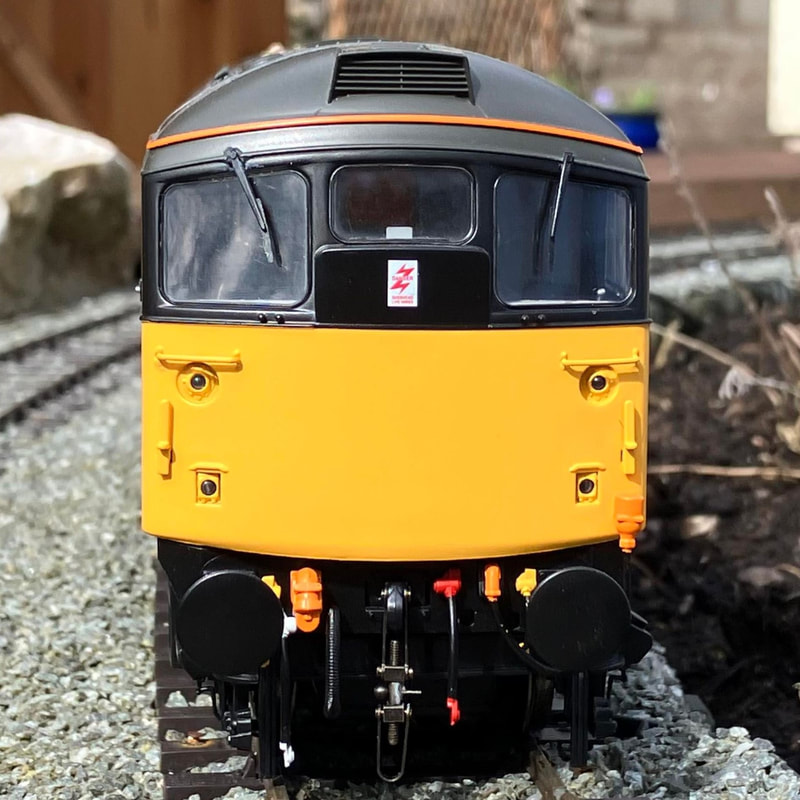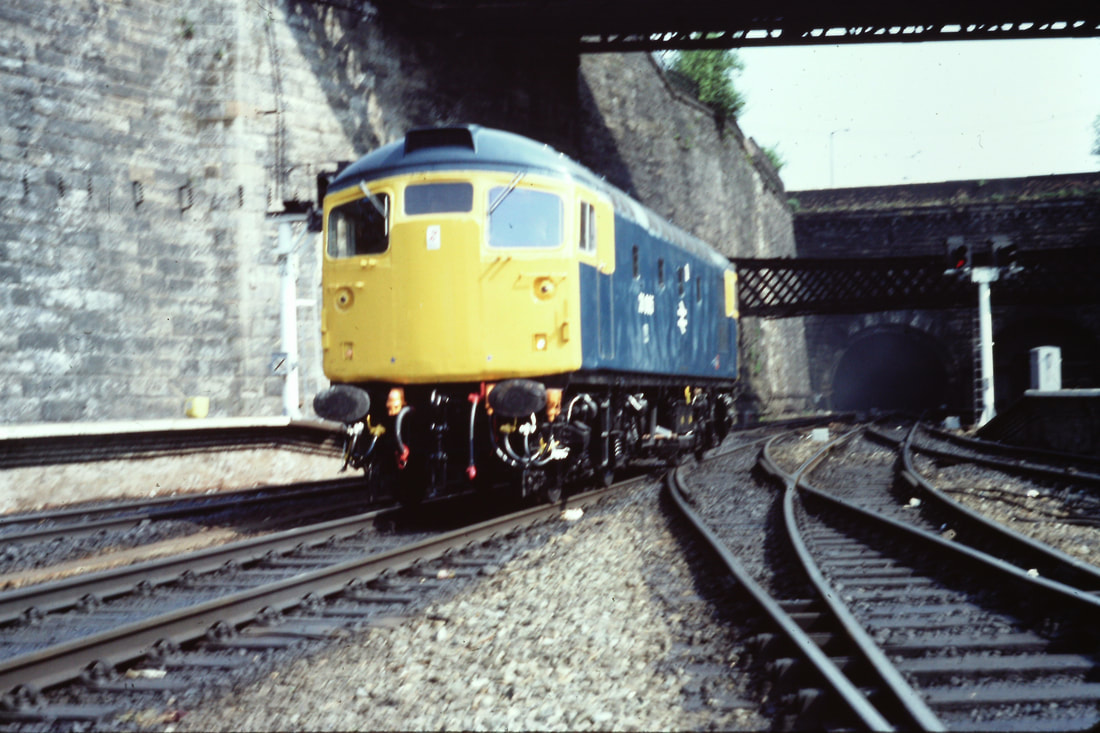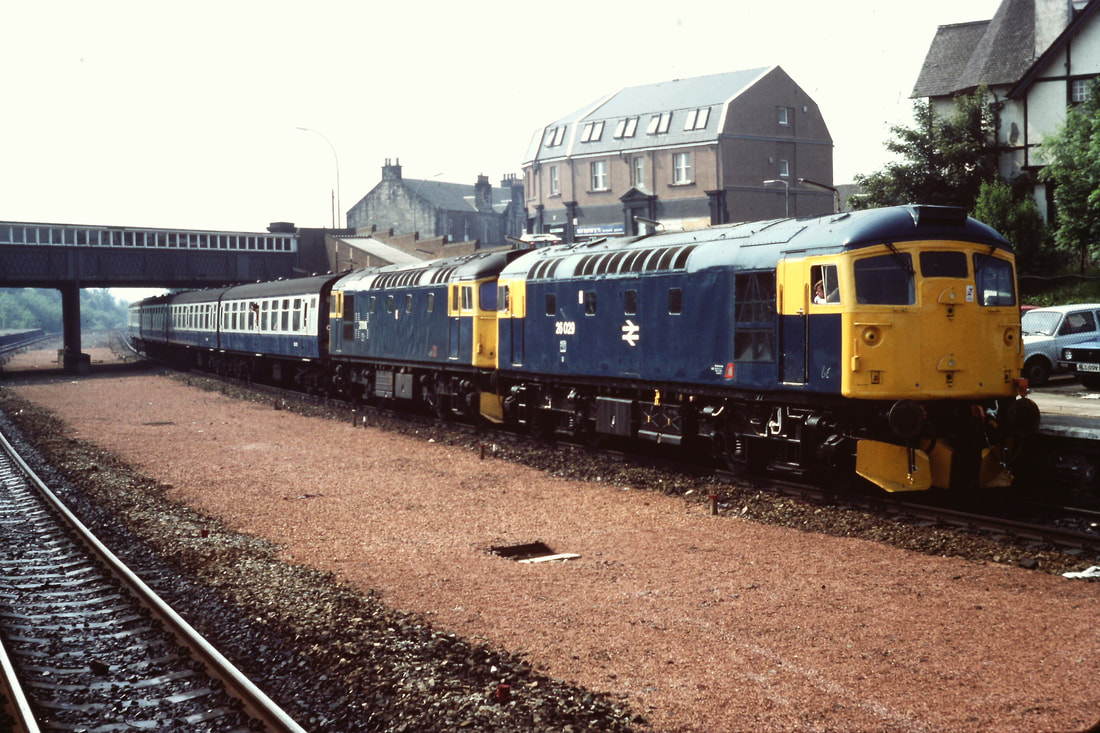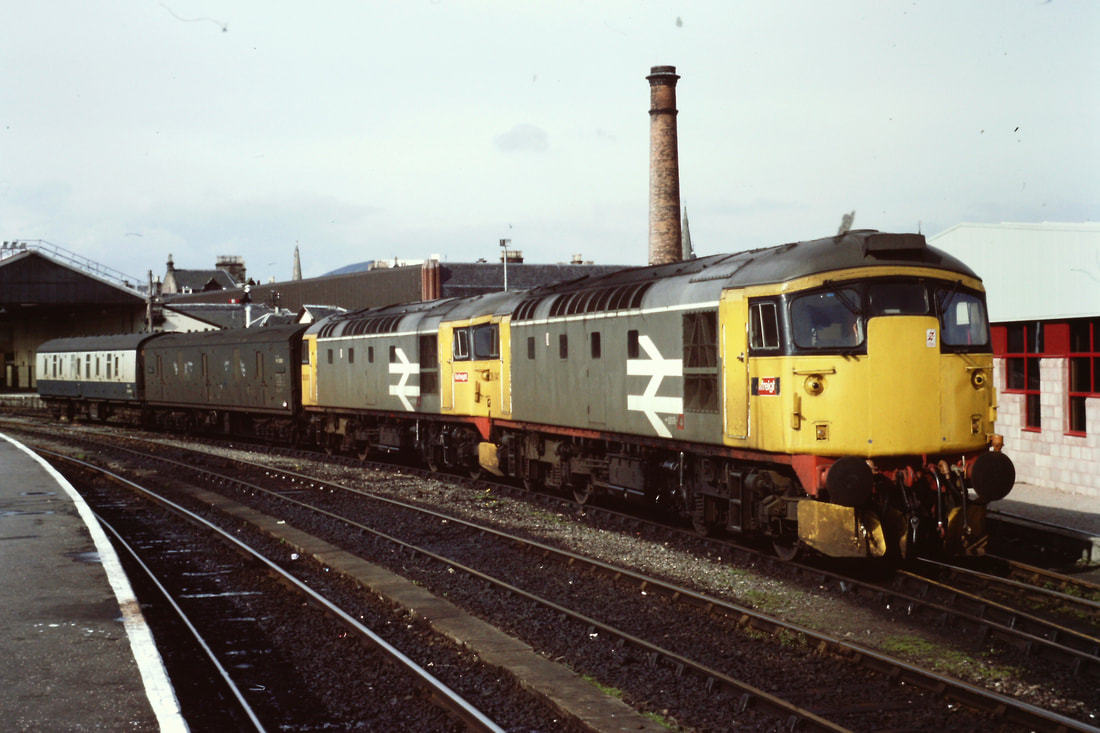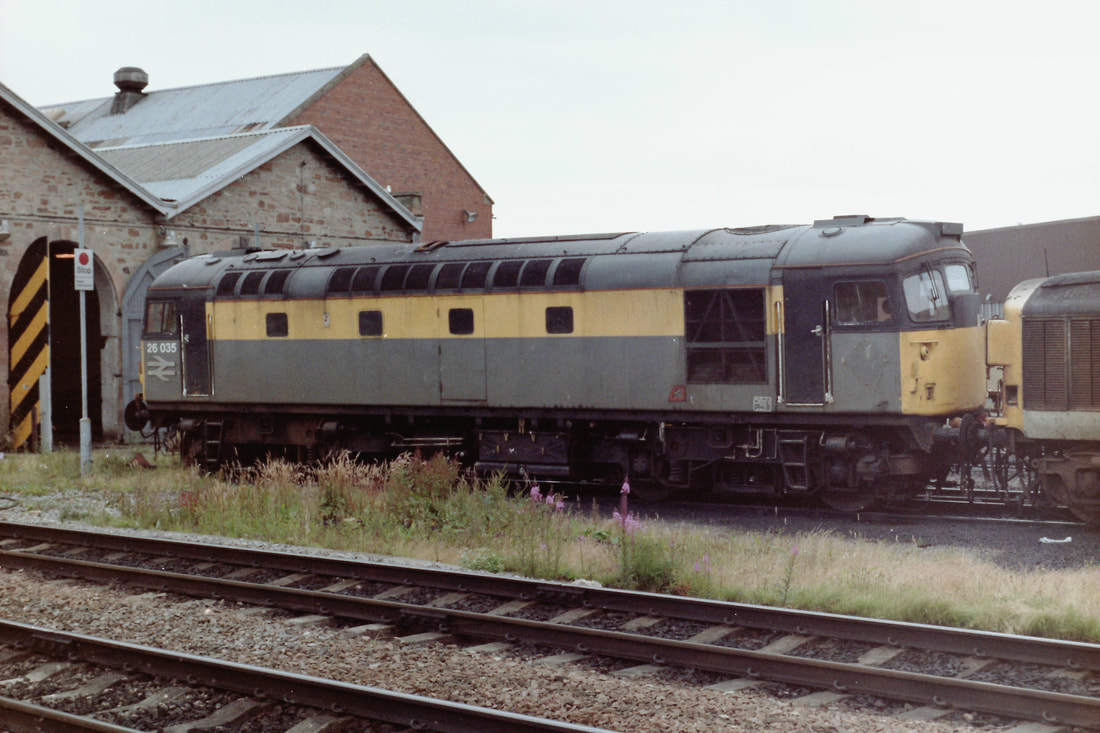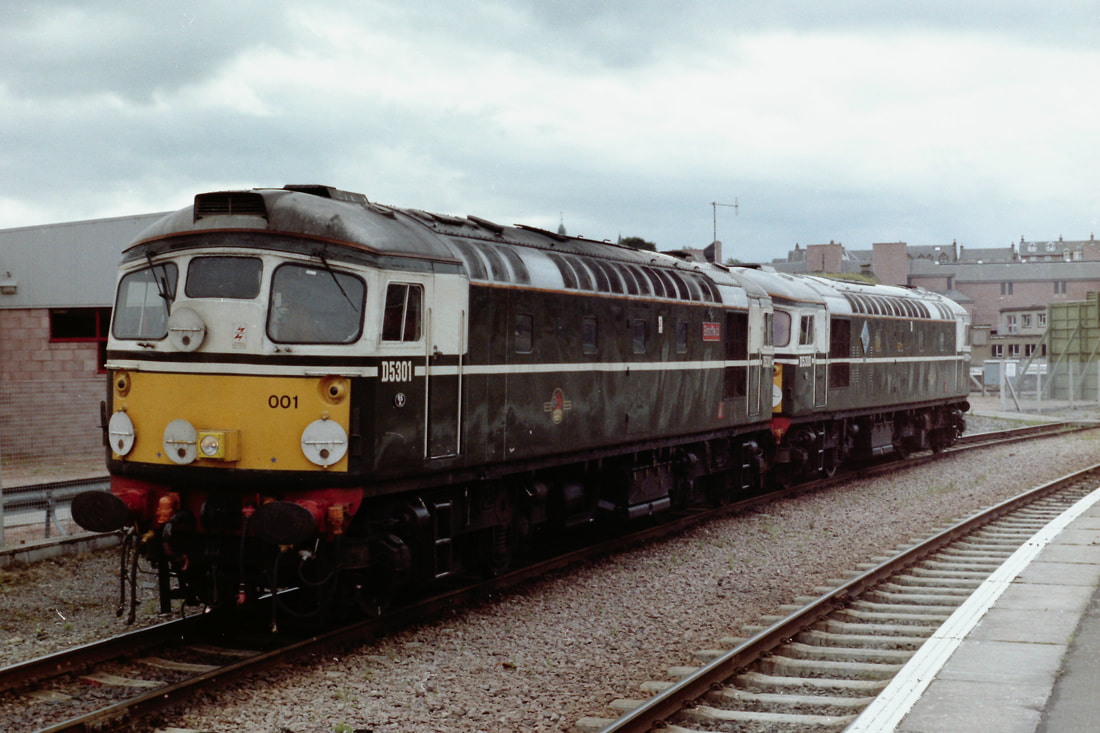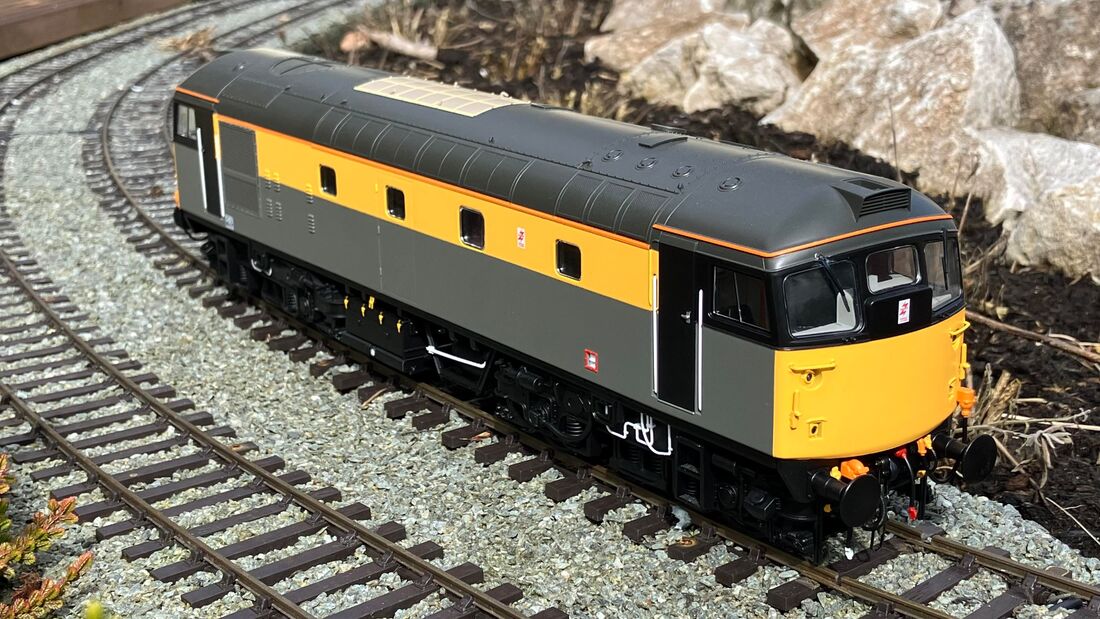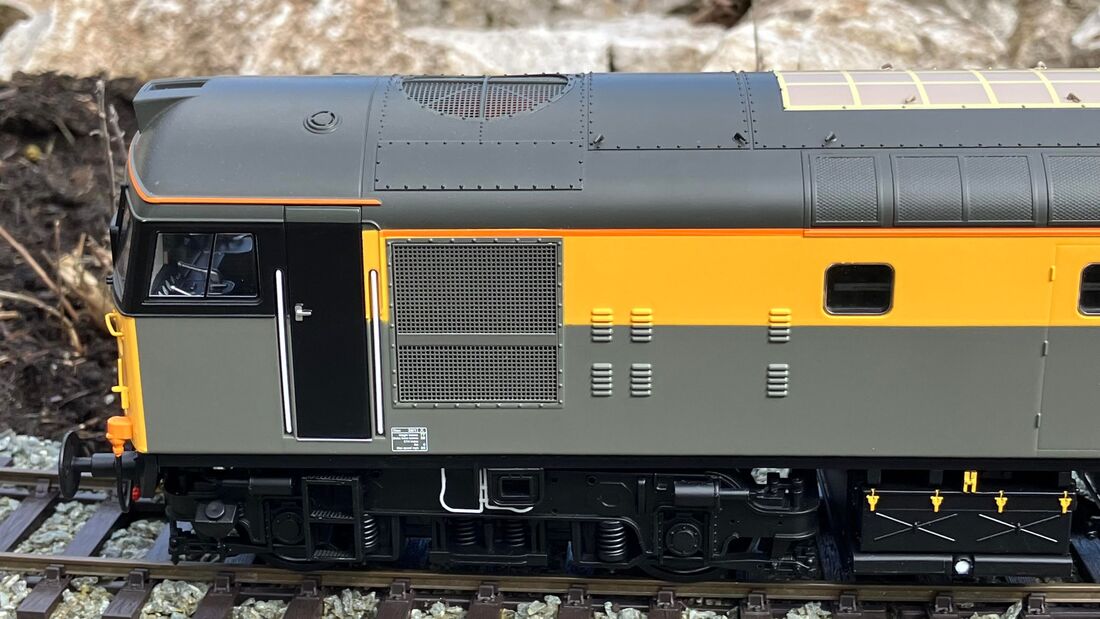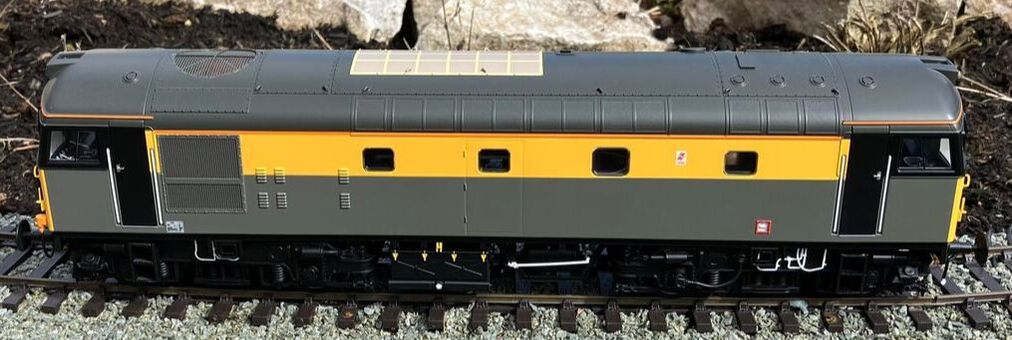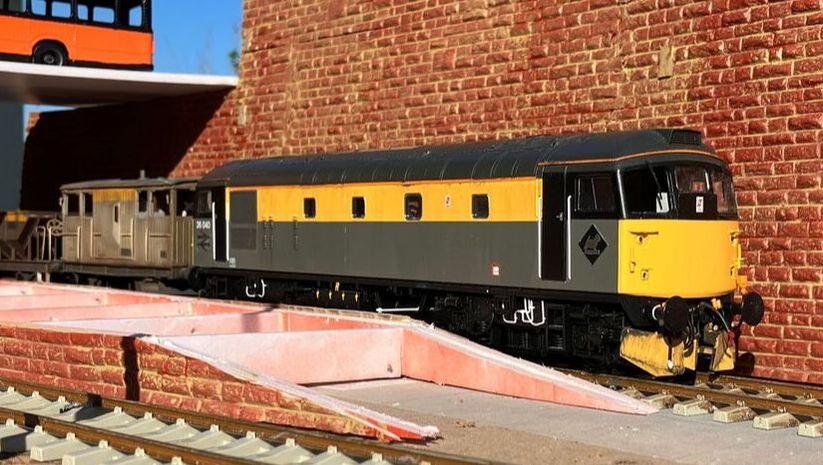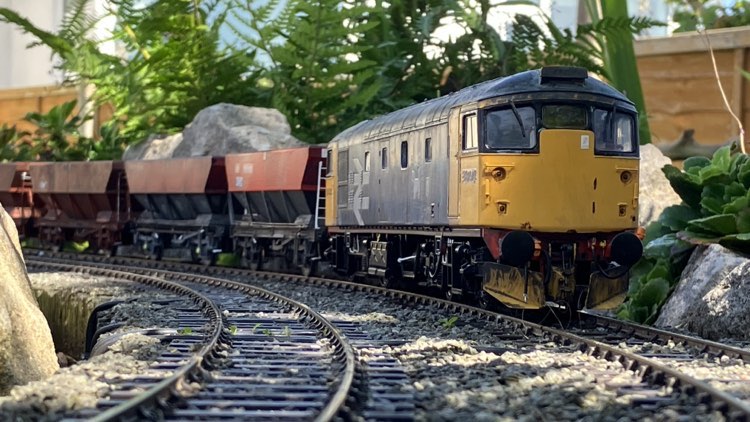|
26034 Rolls into Glasgow Queen Street on the 16th January 1989 with the 09.25 Cowlairs - Glasgow. Image courtesy of Alan Tait.
Review of Heljan Class 26/1
I have had access to one of the 80’s refurbished class 26/1’s carrying the Dutch livery to conduct this review
Although the review is of the Heljan 26/1 release, it’s almost impossible to write an article without giving a background into both the 26/0 and 26/1’s, as the class shared many duties and history. The class is synonymous with Scotland from where they were based from the 1960’s. They had a great reliability record that showed them to be a quality product from the West Midlands. |
A Potted History of the Class
As part of the 1955 Modernisation Scheme Birmingham Railway Carriage and Wagon (BRCW) developed the small Bo-Bo locomotive Powered by a 1160bhp Sulzer straight Six Cylinder engine (6LDA28-A) coupled to Crompton Parkinson Electrical equipment locomotive. The 20 Pilot Scheme locomotives, numbered D5300-5319 with acceptance trials at Doncaster works between July 1958 to March 1959 and then transferred to Eastern Region Hornsey Depot.
They set about taking over workings in and around the Kings Cross area on the former Great Northern Railway routes. This was in a drive to eradicate steam locomotives in the London Suburbs and improve air quality in the capital.
The initial batch proved to be over the specified weight and had an axle loading heavier than expected, as a result their duties were restricted for the first few months. They were banned completely from the Metropolitan Widened Lines and the Cross London Snow Hill route to the Southern Region. The reduced route access issues partly prompted the locomotives to be moved to Scotland. These were designated Class 26/0 would be given the Route Availability (RA) 6 classification. The association with the Class 26 and the Eastern Region ended when in October 1960 when D5318 and D5319 were transferred from Hornsey to Scotland, having been replaced by Brush/Mirrlees Type 2 (later Class 30) locomotives.
With abandonment of the Modernisation Plan and the Pilot Scheme, the desire to eradicate steam across the country. A further 27 modified locomotives were ordered and delivered to the Scottish Region (D5320-D5346) with allocation initially to Inverness. Classified as Class 26/1 these were designated as RA5, as the overall weight of the locomotive had been reduced by 3 and a half tons. This was thanks to revision in the suspension layout and bogie alterations, revision of the upper body grills and changes to the type of buffers fitted.
They set about taking over workings in and around the Kings Cross area on the former Great Northern Railway routes. This was in a drive to eradicate steam locomotives in the London Suburbs and improve air quality in the capital.
The initial batch proved to be over the specified weight and had an axle loading heavier than expected, as a result their duties were restricted for the first few months. They were banned completely from the Metropolitan Widened Lines and the Cross London Snow Hill route to the Southern Region. The reduced route access issues partly prompted the locomotives to be moved to Scotland. These were designated Class 26/0 would be given the Route Availability (RA) 6 classification. The association with the Class 26 and the Eastern Region ended when in October 1960 when D5318 and D5319 were transferred from Hornsey to Scotland, having been replaced by Brush/Mirrlees Type 2 (later Class 30) locomotives.
With abandonment of the Modernisation Plan and the Pilot Scheme, the desire to eradicate steam across the country. A further 27 modified locomotives were ordered and delivered to the Scottish Region (D5320-D5346) with allocation initially to Inverness. Classified as Class 26/1 these were designated as RA5, as the overall weight of the locomotive had been reduced by 3 and a half tons. This was thanks to revision in the suspension layout and bogie alterations, revision of the upper body grills and changes to the type of buffers fitted.
|
26005 drops down into Glasgow QS on the 2nd of June 1982 for the 10.38 Glasgow - Perth. Image courtesy of Alan Tait.
|
Once all the 26/0’s transferred to Scotland they made their homes at Haymarket and Inverness depots, working alongside BR Derby Type 2 Class 24/25 on a number of services. The Inverness locomotives covering routes to the Far North lines for Wick/Thurso and Kyle of Lochalsh. Routes the class would always associated with throughout their career, they could also be found working services to Peterhead, Dundee and Aberdeen as well as the mainline route via Drumochter between Edinburgh and Inverness. From the late 60’s/early 70’s, many of the Inverness locomotives were fitted with centrally fitted headlamps. It is believed that these are similar in design to those fitted to the Austin family of cars. Pairs of type 2’s could often be found working the overnight sleeper trains from Inverness as far south as Perth, later to Edinburgh.
|
The Haymarket allocated locomotives (initially all the 26/0’s) worked all areas around the lowland capital including express trains north to Aberdeen and south to Carlisle via the Waverley route. During late 1966 and early 1967, Seven of the 26/0’s went through works and had their train heat boiler removed, Air Brake cylinders were added in this space, connecting doors welded up, fitment with Air Brakes and Slow Speed Control. These formed a dedicated pool of locomotives for use on MGR coal trains to Longannet and Cockenzie Power Stations, and remained on these services until replacement by Class 56’s. they were a fine sight powering a lengthy train of HAA style hoppers over the Forth Railway Bridge.
Identifying the differences between the two types is usually a matter of looking a number of features. Counting the cant rails grills is one of the most reliable ways to identify the sub-classes from each other. The 26/0 initially having two groups of grills, in a grouping of 3 and 12, The 26/1 having a grouping of 3 and 9. The 26/1 were fitted with sliding cab windows and tablet catcher recesses under the driver’s window from new. 26/0’s initially built with the drop-down windows and some later receiving the sliding windows as a retro fit arrangement. 26019 was unique that the driver’s windows were changed to sliding type, whilst the second man side remained as the drop light type. Bogies are also a major difference with the 26/0 initially having bogies equipped with primary coils and secondary leaf springs in a central lateral beam layout.
Identifying the differences between the two types is usually a matter of looking a number of features. Counting the cant rails grills is one of the most reliable ways to identify the sub-classes from each other. The 26/0 initially having two groups of grills, in a grouping of 3 and 12, The 26/1 having a grouping of 3 and 9. The 26/1 were fitted with sliding cab windows and tablet catcher recesses under the driver’s window from new. 26/0’s initially built with the drop-down windows and some later receiving the sliding windows as a retro fit arrangement. 26019 was unique that the driver’s windows were changed to sliding type, whilst the second man side remained as the drop light type. Bogies are also a major difference with the 26/0 initially having bogies equipped with primary coils and secondary leaf springs in a central lateral beam layout.
|
The driver’s footsteps were of a tapered design, whereas, the 26/1 had straight steps, although these appear to be interchangeable between classes. The 26/1 were fitted with Helical Coiled Springs throughout both primary and secondary suspension, a design that continued under both the Class 27 and 33. There are examples in later years of the early bogies being exchanged and appearing under the 26/1.
The buffers on the original 20 were initially of a heavy oval design, whilst the 26/1 all receiving the large head round lightweight Oleo buffers from new. Some of the 26/0 later receiving this type of buffer. The multiple working jumper was also moved from the buffer beam to body front. As the class passed through works from the mid 1960’s, the end connecting doors were welded up and cab door windows started to be plated over, along with the moving of the door handle to the mid door position, rather than the lower position as built. The class was one of the first to be completely repainted in Corporate BR Blue, with the entire class receiving the colour scheme by mid 1972. The Inverness allocated locomotives once a common sight on the Far North and Kyle Lines were replaced by 37/0’s during the early 1980’s, but they remained active on other routes until they were replaced by locomotives with Electric Train Heating, namely class 47/4. |
26029 & 27018 at Larbert on the 1st of June 1982 with the 13.38 Glasgow QS - Perth. Image courtesy of Alan Tait.
|
|
26041 & 26035 at Inverness on the 6th May 1986. Image courtesy of Alan Tait.
The class being relegated to freight and engineer trains. The class was re-allocated to Eastfield Depot with the entire fleet there from 1991.
Works overhauls in the 1980’s saw that they stripped of asbestos insulation. The front ends were modified leaving them with two white lights at each corner acting and the two upper tail lamps. And a fresh coat of paint in the new house colours. Having undertaken this work it was envisaged that the class would last in service until 2000. However, changes in traffic demands saw them all withdrawn by the end of October 1993. |
|
26035 sits waiting its fate at Inverness on the 5th August 1993. 26035 survives today at the Caledonian Railway at Brechin. Image courtesy of Alan Tait.
In 1992 D5300 (26007) and D5301 (26001) received a makeover into Brunswick Green, with small yellow panels, reinstatement of the head code disks, albeit in a different manner than they were originally fitted, and a hi-intensity light in the central lower body disk area and a pair of cast Eastfield s. Together the pair hauled many farewell tours across the network.
On withdrawal, the class 26 became popular with Preservation Societies and a number are preserved at various railways across the country, included lines that would never have seen them in operational lifespan. |
26001 & 26007 at Inverness on the 4th of August 1993 waiting for one of their final trips to Kyle. Image courtesy of Alan Tait.
|
What’s in the box?
|
Once the lid is off the box there should be a set of instructions and information pack, which oddly refers to the dimensions as a 1:76 model, but are measurements are definitely for a 7mm model. The loco comes on the now common Heljan plank, in a sturdy box that is packed with both high, and low-density foam inserts to hold the loco in place.
|
The Model
The model has been developed to address pretty much all versions of the 26/1. Covering the class from their introduction to withdrawal, and into preservation. With examples with disks and the later refurbished version with flush front with marker lights and High Intensity Lamp.
|
On first examination the model is an excellent representation of the BRCW Type 2/Class 26/1. The mouldings appear crisp and well detailed. The bodyside grills are well represented with the radiator grill providing a view of the framework behind the fine mesh. The opening bodyside window is removable, which is a nice touch as often the class was seen in service with the window in the open position, leaving people thinking the window had been removed or broken.
The lifting hooks and hatch catches on the engine covers on the roof are finely represented and make a superb detail addition. The model has sliding cab windows and some of the models have the recess in the drivers cab side for the tablet catcher equipment. |
The bogies are nicely moulded and are similar to the class 27 bogie frames with moulded springs with added brake pipework and cylinders, sandboxes, speedo cable, and steps. An improvement on Heljans early 26's with the spring detail now set further back.
The buffer beam is well detailed. Dependant on the version there is vacuum brake pipe, steam heat valve and pipe, coupling, sprung Oleo buffers and where fitted, air brake pipes. Pipes and jumper cables are neatly moulded and painted which adds to the appeal of the model. Care needs to be taken when removing the body, as the multiple working jumper cable is attached to both the body and buffer beam. This needs to be detached carefully from the body before removal of the body.
The forward, facing cab ventilator for the air horns the on roof appears to be in the original format for all models. It is known that a large number received various deflectors, covers and plates to reduce the ingress of water and snow into the horns. I’d research your intended model thoroughly to see when the locomotive was fitted with the deflector plate.
The model is powered by 2 vertical motors, with a good size flywheel on the top of the motor in the now familiar Heljan pattern. This is the second locomotive I’ve reviewed with the push fit XL type socket for the DCC decoder. However, it’s not as straight forward just pushing in the decoder as two pins need to be removed for installation in the model as per class 27. Instructions are included, but they’re not exactly detailed. So, it’s not exactly a plug and play system that I expected. I’m not sure whether the removal of these pins will have any impact on your warranty should it decide to stop working. There is a working cooling fan and an identified space for a smoke unit.
The model is fitted with all wheel pick up and directional lighting. There is also internal cab and engine room lighting.
Heljan have certainly got pretty much all the different eras covered with these models. Depending on your era, you’re likely to find a version that suits that period. With a selection of models available that cover from introduction to withdrawal. Heljan have chosen to produce versions with under driver window recess for the token catcher equipment. The green era models also have connecting doors moulded into the body.
The welded up connected doors become common from the mid 1960’s when the standard BR Blue was adopted. Heljan have including an early blue model without yellow wrapped cab windows, the tablet recess and cab doors still have the windows.
There is a version available of the Inverness allocated examples equipped with central twin headlights and welded up doors, a full complement of route indicator disks and plated over cab doors.
The versions that are not covered are those that went through works and had the middle head code disks moved to a central position on the nose end. This was usually undertaken at St Rollox Work, and remained a modification until the disks were declared defunct. After this point the disks appear to be removed completely at later works visits.
Under the later refurbishment program dual braking was applied, any boilers were removed and the route indicators completely removed and just the lower corner. The space where the water tank was now housed extra air cylinders for the air braking. There are finely modelled and NRN pods were fitted to the locos at this time, or as a retrofit item. These are included in the accessory pack with some models as are a pack of miniature snow ploughs and alternative bogie steps.
The buffer beam is well detailed. Dependant on the version there is vacuum brake pipe, steam heat valve and pipe, coupling, sprung Oleo buffers and where fitted, air brake pipes. Pipes and jumper cables are neatly moulded and painted which adds to the appeal of the model. Care needs to be taken when removing the body, as the multiple working jumper cable is attached to both the body and buffer beam. This needs to be detached carefully from the body before removal of the body.
The forward, facing cab ventilator for the air horns the on roof appears to be in the original format for all models. It is known that a large number received various deflectors, covers and plates to reduce the ingress of water and snow into the horns. I’d research your intended model thoroughly to see when the locomotive was fitted with the deflector plate.
The model is powered by 2 vertical motors, with a good size flywheel on the top of the motor in the now familiar Heljan pattern. This is the second locomotive I’ve reviewed with the push fit XL type socket for the DCC decoder. However, it’s not as straight forward just pushing in the decoder as two pins need to be removed for installation in the model as per class 27. Instructions are included, but they’re not exactly detailed. So, it’s not exactly a plug and play system that I expected. I’m not sure whether the removal of these pins will have any impact on your warranty should it decide to stop working. There is a working cooling fan and an identified space for a smoke unit.
The model is fitted with all wheel pick up and directional lighting. There is also internal cab and engine room lighting.
Heljan have certainly got pretty much all the different eras covered with these models. Depending on your era, you’re likely to find a version that suits that period. With a selection of models available that cover from introduction to withdrawal. Heljan have chosen to produce versions with under driver window recess for the token catcher equipment. The green era models also have connecting doors moulded into the body.
The welded up connected doors become common from the mid 1960’s when the standard BR Blue was adopted. Heljan have including an early blue model without yellow wrapped cab windows, the tablet recess and cab doors still have the windows.
There is a version available of the Inverness allocated examples equipped with central twin headlights and welded up doors, a full complement of route indicator disks and plated over cab doors.
The versions that are not covered are those that went through works and had the middle head code disks moved to a central position on the nose end. This was usually undertaken at St Rollox Work, and remained a modification until the disks were declared defunct. After this point the disks appear to be removed completely at later works visits.
Under the later refurbishment program dual braking was applied, any boilers were removed and the route indicators completely removed and just the lower corner. The space where the water tank was now housed extra air cylinders for the air braking. There are finely modelled and NRN pods were fitted to the locos at this time, or as a retrofit item. These are included in the accessory pack with some models as are a pack of miniature snow ploughs and alternative bogie steps.
Conclusion.
|
Although the 26/1 was an early Heljan release at the start of the company’s venture into the UK O gauge scene. The market that has grown dramatically over the past few years. This release updates the model of the 26/1 and is a welcome addition to the Ready to Run sector of the market, especially for those who model Scotland from 1960.
The current updated offering from Heljan is without doubt a highly detailed model of good quality, that covers a variety of eras. Meaning that there is something for everyone. It is a powerful model and is able to haul a good tail load, but it looks as equally at home on a few wagons or coaches as it does on a lengthy train. As with everything prices are on the increase, but there are some suppliers that are offering substantial discounts on the RRP making them excellent value for money. As with all models, and modelling it is important to select your prototype and research thoroughly, as each loco will have its own quirks. I’ve found these two websites really useful for information, as well as the plethora of books in my personal library. https://www.derbysulzers.com/class26b.html https://6lda.wordpress.com/ |
List of available models
Heljan currently lists the following liveries as available.
#2674 BR Blue 26032 (twin headlights/Highland stags) TOWER MODELS EXCL.
#2675 BR green unnumbered
#2676 BR green with small yellow panels unnumbered
#2677 BR Blue (early) unnumbered
#2678 BR Blue with twin headlights unnumbered
#2679 BR Blue 26037 WEATHERED
#2680 BR Blue unnumbered (air tanks)
#2681 Railfreight 'Red Stripe' unnumbered
#2682 BR Civil Engineers grey/yellow unnumbered
#2863 Railfreight 'Red Stripe' 26025 WEATHERED
#2674 BR Blue 26032 (twin headlights/Highland stags) TOWER MODELS EXCL.
#2675 BR green unnumbered
#2676 BR green with small yellow panels unnumbered
#2677 BR Blue (early) unnumbered
#2678 BR Blue with twin headlights unnumbered
#2679 BR Blue 26037 WEATHERED
#2680 BR Blue unnumbered (air tanks)
#2681 Railfreight 'Red Stripe' unnumbered
#2682 BR Civil Engineers grey/yellow unnumbered
#2863 Railfreight 'Red Stripe' 26025 WEATHERED
Proudly powered by Weebly
